Abstract
Suspected outbreaks caused by pseudomonas aeruginosa in 19 hospitals and two motels were studied. On the basis of epidemiological analysis, serological typing, and antibiotic resistance patterns, 17 were classified as single-strain outbreaks. Six were classified as common-source outbreaks: of these, three were caused by contaminated urological instruments or solutions, two involved bathing in contaminated whirlpools, and one was caused by contaminated lens prostheses implanted during eye surgery. The ability of P. aeruginosa to survive or grow in wet environments was important in each of these six outbreaks. Eight outbreaks were classified as cross-infection. Two involved the urinary tract and were caused by antibiotic-resistant strains. Six involved the respiratory tract, but only one was caused by an antibiotic-resistant strain. In 2 of the 17 single-strain outbreaks, the exact mode of transmission could not be determined. One was an outbreak of pseudobacteremia in which patient blood cultures were contaminated with a single strain, presumably during collection of specimens or culture processing, P. aeruginosa serogroup O11 caused 9 of 17 (53%) single-strain outbreaks, a surprising finding since this serogroup represents only about 8% of endemic hospital isolates of this species. Serotyping was very useful in epidemiological analysis, but antibiotic susceptibility patterns were less useful.
Full text
PDF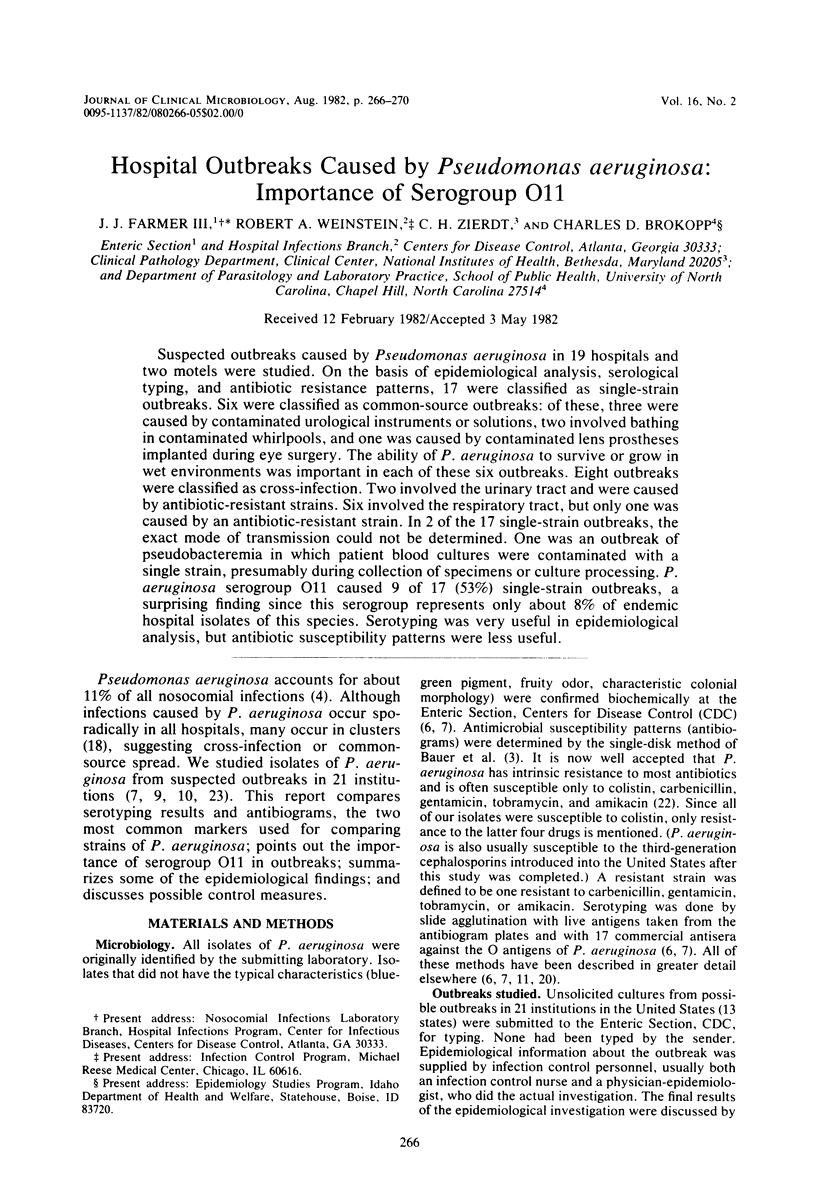
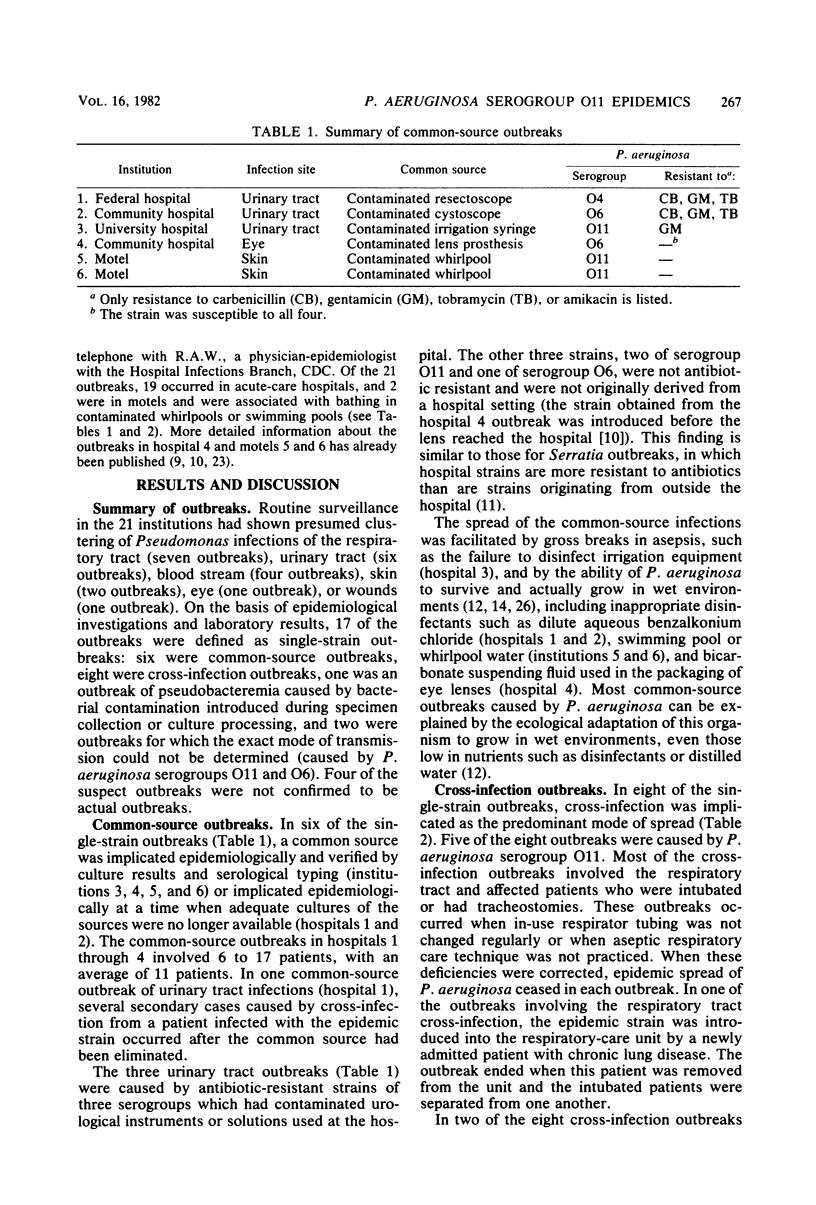
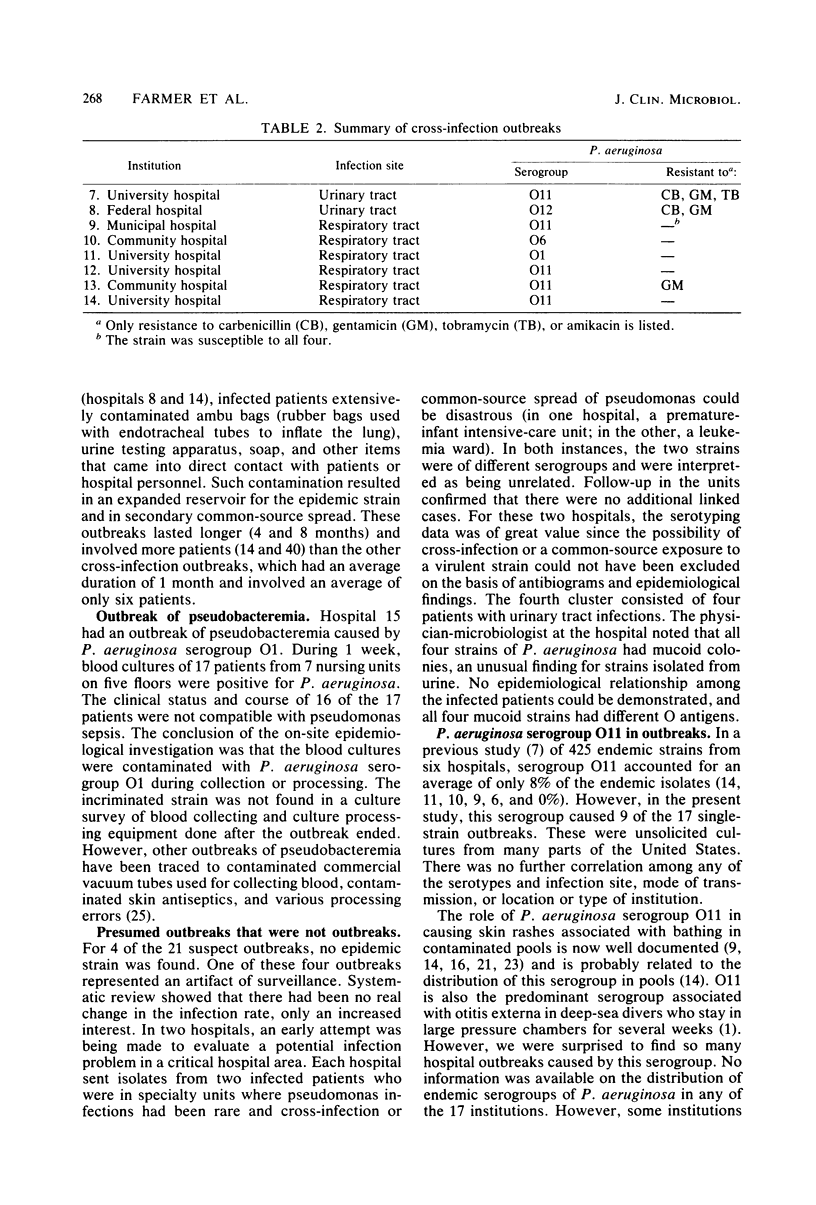
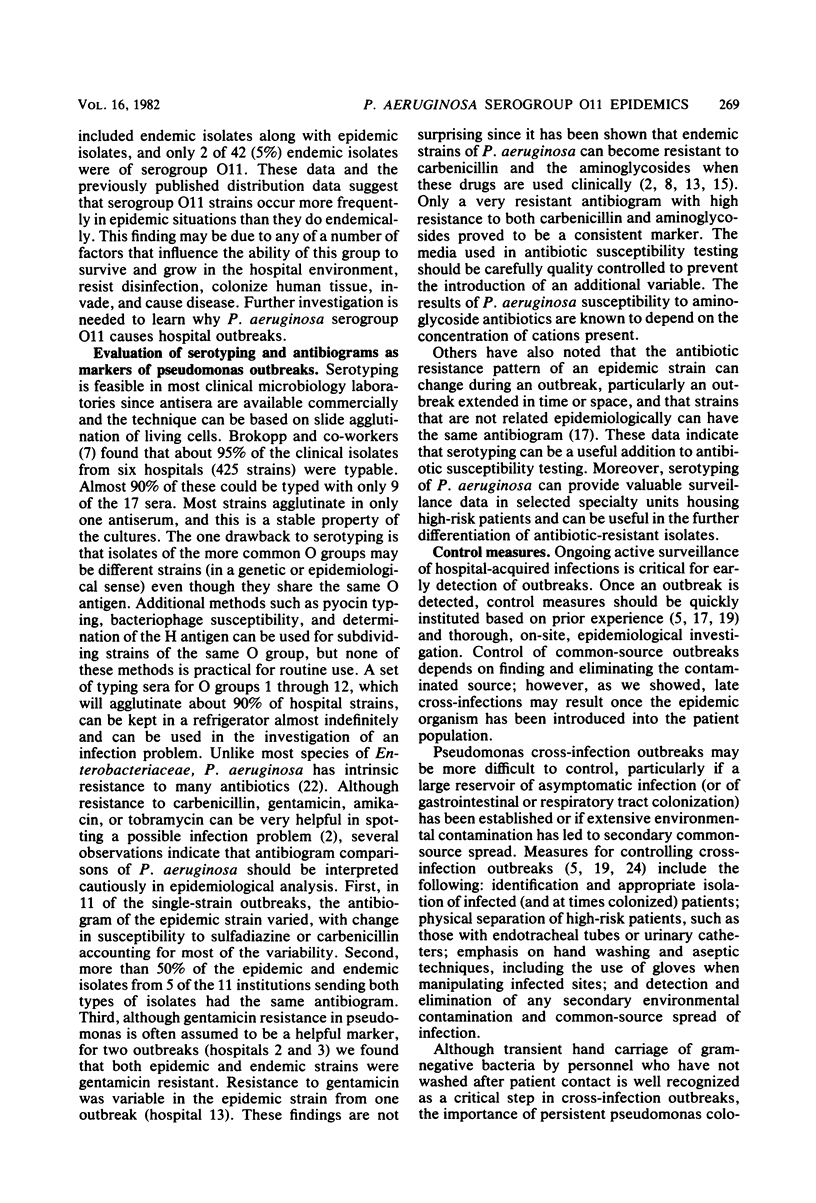
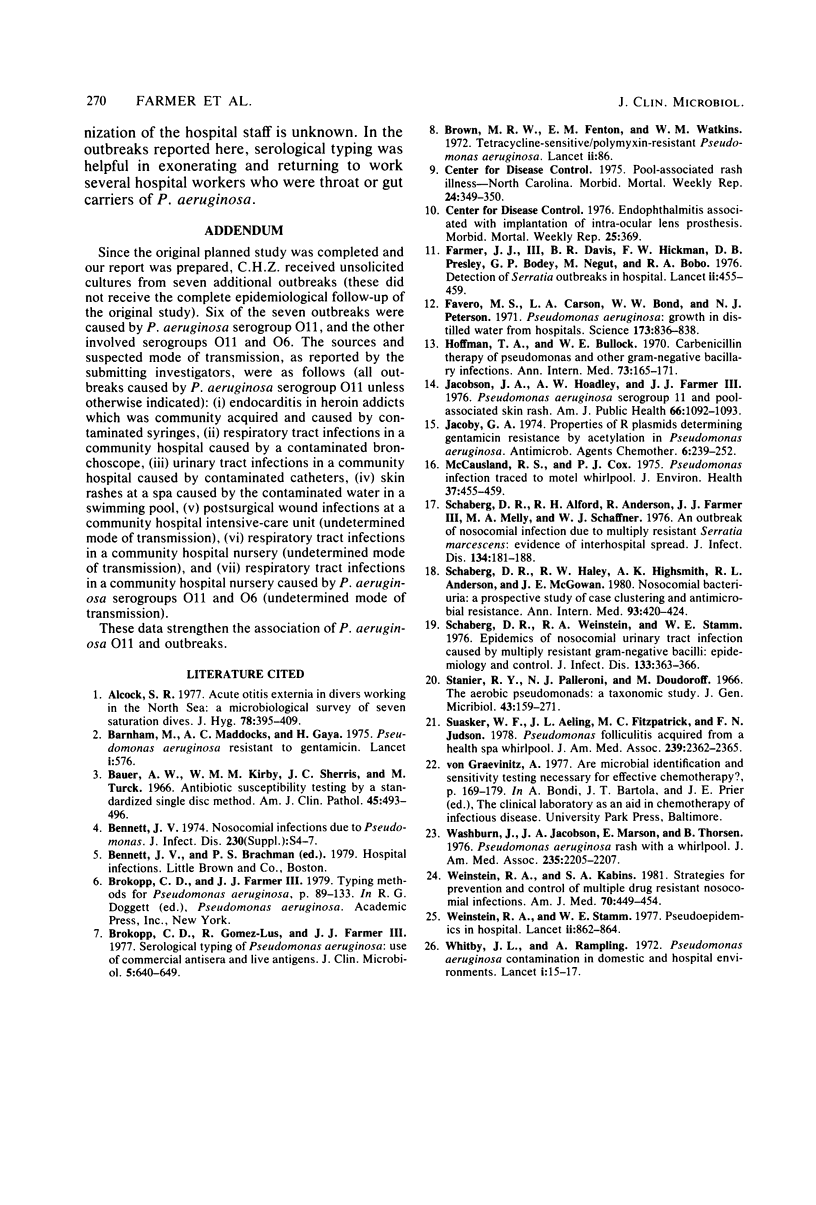
Selected References
These references are in PubMed. This may not be the complete list of references from this article.
- Alcock S. R. Acute otitis externa in divers working in the North Sea: a microbiological survey of seven saturation dives. J Hyg (Lond) 1977 Jun;78(3):395–409. doi: 10.1017/s0022172400056291. [DOI] [PMC free article] [PubMed] [Google Scholar]
- Barnham M., Maddocks A. C., Gaya H. Letter: Pseudomonas aeruginosa resistant to gentamicin. Lancet. 1975 Mar 8;1(7906):576–576. doi: 10.1016/s0140-6736(75)91596-2. [DOI] [PubMed] [Google Scholar]
- Bauer A. W., Kirby W. M., Sherris J. C., Turck M. Antibiotic susceptibility testing by a standardized single disk method. Am J Clin Pathol. 1966 Apr;45(4):493–496. [PubMed] [Google Scholar]
- Bennett J. V. Nosocomial infections due to Pseudomonas. J Infect Dis. 1974 Nov;130 (Suppl)(0):S4–S7. doi: 10.1093/infdis/130.supplement.s4. [DOI] [PubMed] [Google Scholar]
- Brokopp C. D., Gomez-Lus R., Farmer J. J., 3rd Serological typing of Pseudomonas aeruginosa: use of commercial antisera and live antigens. J Clin Microbiol. 1977 Jun;5(6):640–649. doi: 10.1128/jcm.5.6.640-649.1977. [DOI] [PMC free article] [PubMed] [Google Scholar]
- Brown M. R., Fenton E. M., Watkins W. M. Tetracycline-sensitive polymyxin-resistant Pseudomonas aeruginosa. Lancet. 1972 Jul 8;2(7767):86–86. doi: 10.1016/s0140-6736(72)91568-1. [DOI] [PubMed] [Google Scholar]
- Farmer J. J., 3rd, Davis B. R., Hickman F. W., Presley D. B., Bodey G. P., Negut M., Bobo R. A. Detection of Serratia outbreaks in hospital. Lancet. 1976 Aug 28;2(7983):455–459. doi: 10.1016/s0140-6736(76)92539-3. [DOI] [PubMed] [Google Scholar]
- Favero M. S., Carson L. A., Bond W. W., Petersen N. J. Pseudomonas aeruginosa: growth in distilled water from hospitals. Science. 1971 Aug 27;173(3999):836–838. doi: 10.1126/science.173.3999.836. [DOI] [PubMed] [Google Scholar]
- Hoffman T. A., Bullock W. E. Carbenicillin therapy of Pseudomonas and other gram-negative bacillary infections. Ann Intern Med. 1970 Aug;73(2):165–171. doi: 10.7326/0003-4819-73-2-165. [DOI] [PubMed] [Google Scholar]
- Jacobson J. A., Hoadley A. W., Farmer J. J., 3rd Pseudomonas aeruginosa serogroup 11 and pool-associated skin rash. Am J Public Health. 1976 Nov;66(11):1092–1093. doi: 10.2105/ajph.66.11.1092. [DOI] [PMC free article] [PubMed] [Google Scholar]
- Jacoby G. A. Properties of R plasmids determining gentamicin resistance by acetylation in Pseudomonas aeruginosa. Antimicrob Agents Chemother. 1974 Sep;6(3):239–252. doi: 10.1128/aac.6.3.239. [DOI] [PMC free article] [PubMed] [Google Scholar]
- Sausker W. F., Aeling J. L., Fitzpatrick J. E., Judson F. N. Pseudomonas folliculitis acquired from a health spa whirlpool. JAMA. 1978 Jun 2;239(22):2362–2365. doi: 10.1001/jama.239.22.2362. [DOI] [PubMed] [Google Scholar]
- Schaberg D. R., Alford R. H., Anderson R., Farmer J. J., 3rd, Melly M. A., Schaffner W. An outbreak of nosocomial infection due to multiply resistant Serratia marcescens: evidence of interhospital spread. J Infect Dis. 1976 Aug;134(2):181–188. doi: 10.1093/infdis/134.2.181. [DOI] [PubMed] [Google Scholar]
- Schaberg D. R., Haley R. W., Highsmith A. K., Anderson R. L., McGowan J. E., Jr Nosocomial bacteriuria: a prospective study of case clustering and antimicrobial resistance. Ann Intern Med. 1980 Sep;93(3):420–424. doi: 10.7326/0003-4819-93-3-420. [DOI] [PubMed] [Google Scholar]
- Schaberg D. R., Weinstein R. A., Stamm W. E. Epidemics of nosocomial urinary tract infection caused by multiply resistant gram-negative bacilli: epidemiology and control. J Infect Dis. 1976 Mar;133(3):363–366. doi: 10.1093/infdis/133.3.363. [DOI] [PubMed] [Google Scholar]
- Stanier R. Y., Palleroni N. J., Doudoroff M. The aerobic pseudomonads: a taxonomic study. J Gen Microbiol. 1966 May;43(2):159–271. doi: 10.1099/00221287-43-2-159. [DOI] [PubMed] [Google Scholar]
- Washburn J., Jacobson J. A., Marston E., Thorsen B. Pseudomonas aeruginosa rash associated with a whirlpool. JAMA. 1976 May 17;235(20):2205–2207. [PubMed] [Google Scholar]
- Weinstein R. A., Kabins S. A. Strategies for prevention and control of multiple drug-resistant nosocomial infection. Am J Med. 1981 Feb;70(2):449–454. [PubMed] [Google Scholar]
- Weinstein R. A., Stamm W. E. Pseudoepidemics in hospital. Lancet. 1977 Oct 22;2(8043):862–864. doi: 10.1016/s0140-6736(77)90793-0. [DOI] [PubMed] [Google Scholar]
- Whitby J. L., Rampling A. Pseudomonas aeruginosa contamination in domestic and hospital environments. Lancet. 1972 Jan 1;1(7740):15–17. doi: 10.1016/s0140-6736(72)90006-2. [DOI] [PubMed] [Google Scholar]


